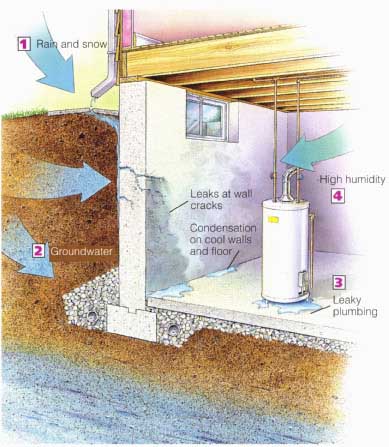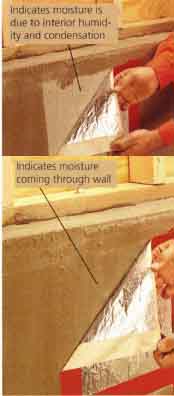Basements are leak prone, but you don’t have to live in fear of those leaks and abandon your basement as a living area. Most leakage can be prevented, often with surprisingly little effort and cost. In addition to the solutions on the following pages, here are simple things you can do to avoid the shock of walking downstairs and stepping on soggy carpet.
• Make sure gutters are clean and sloped properly. Install larger 4-in. (10-cm) downspouts to discourage clogging.
• Properly seal around basement windows and doors with caulk or silicone.
• Test sump pump to ensure proper functioning by pouring water in the sump catch basin. Install a battery backup in case of power failure.
• To avoid bursting a water line, remove hoses from outdoor faucets before freezing weather comes.
• Test floor drains for proper functioning.
• Replace low-quality plumbing lines. Instead of flexible pipe, use PVC or ABS pipe for sump pump discharge. Install steel-braided no-burst supply lines on your washer.
• Repair poorly flashed deck ledger boards, windows and doors.
The first step in solving a water problem is to figure
out the water source among four possible suspects: rain, groundwater,
leaky plumbing, or condensation.

1. Rain. Water from rainfall and snow will eventually penetrate your basement if you don’t direct it away from the foundation. To do this, keep gutters and other drainage systems functioning properly and make sure landscape and concrete pads slope away from the foundation walls.
2. Groundwater. Leakage from ground water occurs when the soil around the foundation becomes saturated with water and presses against the basement walls, causing hydrostatic pressure. Rain fall amount, soil type and water table level can all play a role in groundwater problems. To control groundwater leak age, your home may require installation of a drain tile system or repairs to an existing one.
3. Plumbing leaks. Water pooling on the basement floor may come from a leaky water pipe, water heater, outdoor faucet, sump-pump discharge pipe (especially the flexible type) or another plumbing source.
4. Condensation. On warm, humid days, water can condense on the cool basement walls and floors, encouraging the growth of mold and mildew.
Conducting a Moisture Test

Even if you see no visible puddles from leaky cracks, moisture may still
be entering through the basement’s concrete walls and floor. Many houses
are constructed loosely enough to naturally vent this moisture, but tighter
homes often trap this moisture inside, resulting in high indoor humidity.
This humidity can cause peeling paint, mold and mildew, and condensation
on windows leading to wood rot. To distinguish between condensation and seepage, conduct this test: On a warm, humid day, dry a spot on the floor
or wall using a hair dryer. Tape a piece of foil or plastic over the
dry spot. Thoroughly seal all four sides and wait two days. Then check:
If moisture has collected on the foil’s exposed face, but the concrete behind is dry, moisture is due to interior basement humidity condensation.
If water has accumulated on the foil’s side facing the wall, moisture is coming through wall or floor seepage. If the source is condensation, reduce humidity with a dehumidifier. If your home is equipped with refrigerated air conditioning, it already has a dehumidifier, but the basement area may require additional help. If the source is seepage, see next page for solutions.